 |
| leading the way to the
new storage frontier | |
... |
| ..... |
|
SSD history
top SSD companies
what's the state of DWPD?
Capacitor
hold up times in 2.5" military SSDs
is remanence in
persistent memory a new security risk?
where are we
heading with memory intensive systems and software?
what were
the big memory architecture ideas which emerged in 2016? |
|
| ... |
|
|
|
|
| ... |
|
 |
|
... |
|
| is it realistic to talk
about memory IOPS? |
Editor:- August 11, 2016 -
24
million IOPS on a single device is the title of a recent blog from Storage Switzerland which is a
briefing note about Crossbar
which operates in the conerging segments of the
alt nvm and
DIMM wars
markets.
Among other things author - George Crump - says "Crossbar
believes that it can achieve 24 million IOPS on a single 4TB NV-DIMM without the
use of a RAM buffer or a capacitor." ...read
the article
Editor's comments:- when startups enter new
emerging markets they are often tempted to make headline grabbing claims.
And I think the "24 million IOPS" (IOPs as in you
and I think about them) has to be interpreted in that context. (How can you
claim record breaking IOPS when all you've got is a memory IP - and that's just
part of a yet to be integrated technology set which together make IOPs.)
This
is not to decry the importance and validity of the
tides of
change in the SCM SSD DIMM wars market - which have consumed nearly
half of my working hours in the past year.
We saw similar wild
claims when the startup Fusion-io
was trying to get across how
PCIe SSDs would change
the enterprise storage market by reference to the nearest similar technology
when Fusion said in 2007 it would replace SANs. (Because SAN based SSD
accelerators were at that time the SSD market's dueling weapons of choice.)
Going
back to Crossbar - there is a genuine problem for the industry (which I touched
on in an earlier post about Diablo's
DMX software) - which is - what are the most useful metrics to judge tiered
memory systems by?
As we've seen in the
SSD accelerated storage
pool market since 2009 - there's a wide spectrum of use cases and cost
considerations which have many viable business intersections.
We
need new "goodness" numbers for DIMM wars memories.
But I
think using IOPS to characterize a memory product is less useful to describe why
people might want to look at it than wattage, raw capacity in a DIMM,
uncached raw R/W latency and price.
And - most important of all -
what software does it work with? And how well does the software behave? | | |
|
... |
|
| Micron's QuantX
Development Board - pics on Tom's Hardware |
Editor:- August 12, 2016 - A year after Intel and Micron preannounced
their 3DXPoint / Optane bid for the
alt nvm
DIMM wars
market (with the absence of any worthwhile technical details) we now know
that you might have to wait another year to buy any.
But the companies
have released more preliminary tech data and this week have been showing
prototype development boards at FMS.
You
can see a useful article about this -
3D
XPoint SSD Pictured - on Tom's
Hardware.
Among other things this says the new memories will
have an endurance rating of 25 DWPD.
Also
speed will not be fast as (selectively) promised last year.
This
shouldn't come as any surprise to regular readers.
In
June 2016 I
recommended a video 3D
XPoint, reality, opportunity, competition by Yung Lee,
President & CEO - BeSang
- who correctly (as it turns out) reinterpreted the performance claims of 3D
XPoint and looked at the limitations, manufacturing costs and best likely
application roles for this new technology from a deep semiconductor perspective.
Why
is Micron rebranding the memory to QuantX? - the 3rd name for the same memory
(so far).
Well why did Microsoft skip ahead to Windows 10?
Branding SSD related
products is not as easy as you might think.
But it could be that by
the time anyone can see these new products in an online shopping basket the
original name will seem old. | | |
|
... |
|
|
|
|
| ... |
|
| does
persistent memory pose new new security risks? |
Editor:- August 4, 2016 - 35 years ago I noticed
something curious about RAM which surprised me. But it wasn't important for my
work at the time.
In a new blog on StorageSearch.com -
is data
remanence in persistent memory a new risk factor? - I link together some
ideas which pinged across my path 3 times in as many decades. But I think these
have more relevance now in the new context of emerging persistent memory
systems. ...read
the article | | |
|
... |
|
| fast is good - more is
better |
Editor:- August 9, 2016 - In some ways Mangstor has some
quaint old fashioned ideas because its products are to be found in the
segment of raw enterprise performance and you'll find them listed along with
some others in my indicative article -
the fastest SSDs.
Speed was indeed the gateway which opened the access to the
enterprise SSD market back in the days of
yore -
although just as with cars - having long ago proved that
SSDs can run
faster than hard driven horses - the enterprise market has recently grown
more sophisticated in its analysis of
user
requirements - even to the extent that vendors are now offering pricing
schemes which are
abstracted
far away from traditional cost for capacity ideas of rotating storage.
Which
brings me back to Mangstor - a company I described last year as having "less
employees than cores in its SSD controllers."
There is another
old fashioned business idea which we've seen has to be satisfied for any such
company to succeed for long in the market. They have to be able to answer this
question - posed by their ideal hypothetical customers...
Yes we
like what your product does - but do you have an easy way we can use a lot of
them together - which preserves the essential character of
attributes we
like - without crossing over into product territories which other vendors do
better?
Many products which look like stars as solo SSDs fail such
scalability symmetry
tests.
Mangstor's answer to such a question can be seen in an
announcement
today - " the availability of its TITAN NVMe over Fabric (NVMf) Target
Software Storage Stack which tightly integrates NVMe SSDs with Remote Direct
Memory Access (RDMA) NICs and efficient use of x86 server capabilities to
deliver network storage performance with upto 10x higher bandwidth and
1/10th the latency compared to iSCSI and FC-based AFAs."
Mangstor also says - its NVMf arrays based on TITAN software scale to
petabytes of capacity and hundreds of GB/s as arrays are added with virtually no
increase in latency.
In case you didn't see this article earlier - the
value of low latency in enterprise SSD contexts was elegantly summarized in
the SSD Bookmarks by
IBM. | | |
|
... |
|
 |
|
... |
|
| lowering cloud wattage
with low DWPD SATA SSDs |
Editor:- August 4, 2016 - Although it's the
faster SSD products (like PCIe
SSDs and memory
channel SSDs) which capture the attention of readers - because they show
what is possible (and after a long enough interval we see pioneering
enterprise speeds becoming commonplace at lower
prices as we're now
seeing with M.2 SSDs)
nevertheless - when it comes to where most of the SSD slots are - the workhorse
of the SSD market - in arrays, webscale and cloud - is still the simple
2.5"
SATA SSD.
Well, maybe not that simple - because since about
2012 we
started to see subtle power optimized and mostly read oriented (low
DWPD) SATA SSD product
lines being introduced specifically for use in dense populations in the
cloud.
It's a
big market for SSD
vendors and SATA SSDs
are a low risk choice for users because there are so many competing companies
and products that ensure continuous improvements in value and quality.
A
new addition to this crowded market is the -
Nytro
XF1230 (pdf) - a 1.9TB capacity SSD which consumes less than 5W, is
rated at 0.67 DWPD -
which Seagate
announced
will ship to channel partners next month. | | |
|
... |
|
 |
|
... |
|
there was a flash memory
bard
who said it's not really that hard
playing limerick sports
takes
less time than reports
as all the words fit on a card |
Editor:- August 24, 2016 - In case you missed it
- there were a LOT of
entries
in the Flash Memory Limerick competition organised by NVMdurance.
The
draw winner - announced
at the Flash Memory Summit
- was Tom
Coughlin, President Coughlin Associates.
You
can read Tom's winning entry and many other fine examples from people in the
SSD industry who have invented many playful ways to link the ideas of
endurance, flash, SSDs and even business development themes in unique ways
that have never before been seen in
SSD history.
...read
all the limericks | | |
|
... |
|
|
|
|
... |
|
... |
|
 |
|
... |
|
|
|
|
|
|
|
| |
|
|
|
|
patent in China for NVMdurance's flash
software
Editor:- August 31, 2016 - NVMdurance today
announced it has been
granted a patent in China related to its endurance optimization software.
There
are several aspects to the company's multi-stage lifecycle endurance
management.
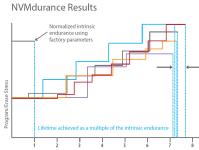 During
the memory characterization and design phase its Pathfinder software
determines multiple
sets of viable flash register values, using a custom-built suite of
machine-learning techniques. During
the memory characterization and design phase its Pathfinder software
determines multiple
sets of viable flash register values, using a custom-built suite of
machine-learning techniques.
Then in production, controllers which
use its Navigator firmware choose which of these predetermined sets to use for
each stage of life to ensure that the flash lasts as long as possible.
new MIL-STD-461E/F EMI filtered NAS JBOD SSD from V&G
Editor:-
August 24, 2016 - I found it interesting to see the level of detail available
in the datasheet for a new rugged 8TB NAS JBOD SSD box (8.66 in (L) x 7.61 in
(W) x 4.65 in (H)) from V&G
because often such vital info is missing unless you sign up to get it. Among
other things - the
RVAS3400
(pdf) has these features and options:-
 256-bit
AES encryption utilizing NIST, CSE, and FIPS140-2 certified encryption chips.
Encryption keys can be loaded over ethernet or stored on the system's
controller. The controller has a TPM security device for secure storage of the
encryption keys. 256-bit
AES encryption utilizing NIST, CSE, and FIPS140-2 certified encryption chips.
Encryption keys can be loaded over ethernet or stored on the system's
controller. The controller has a TPM security device for secure storage of the
encryption keys.
The RVAS3400 supports zeroization (SSD erase) procedures,
meeting both DOD NISPOM 5220.22 and NSA/CSS 9-12 specifications.
The
time to erase using ATA Secure Erase is approximately 5 seconds, using NSA Erase
it is approximately 16 minutes, and using DOD Erase it is approximately 48
minutes. (Erase times do not vary based on the amount of storage.)
- Internal holdup:- 100ms @ 70W.
- Integrated support for MIL-STD-704 28 VDC.
- Weight:- less than 12 lbs.
See also:-
military SSDs,
the business of SSD
customization
new industrial secure eUSB 3.0 10-pin SSDs from Virtium
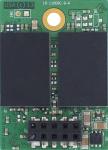 Editor:-
August 22, 2016 - Virtium
recently
announced
new models of eUSB 3.0 10-pin models in its TuffDrive SSD range which offers
much faster speed than eUSB 2.0 at about half the power consumption. Editor:-
August 22, 2016 - Virtium
recently
announced
new models of eUSB 3.0 10-pin models in its TuffDrive SSD range which offers
much faster speed than eUSB 2.0 at about half the power consumption.
Capacities
range from 2GB to 256GB, while drawing less than 1W. Size is 36.9mm x 26.6 mm.
See
also:- USB SSDs,
M.2 SSDs
Plexistor demonstrates low latency memory fabric on commodity
hardware
Editor:- August 19, 2016 - If you don't want to be tied
to any particular proprietary big memory hardware - but do need memory fabric -
what kind of performance can you expect using
software absrtaction
products?
Plexistor
recently demonstrated it can handle millions of remote writes per second at
latencies as low as a few microseconds in a benchmark on Mellanox
infrastructure over 100GbE using Plexistor's persistent memory over fabric
software.
Benchmarks performed on a Mellanox infrastructure over 100GbE
using Plexistor's PMoF Brick demonstrated record performance: more than 1.6
million random 4KB IOPS at less than 6µs with throughput of 7GB/sec.
where memory goes - compression follows
Editor:-
August 19, 2016 - Cache memory compression techniques and a survey of why and
where they can be useful featured in a
news story here
in April 2015
and was part of the rethinking RAM
in an SSD context industry trend which is sweeping across computer
architecture.
But where can we find examples of such techniques being
used?
A recent case is a
new version
of software from A3Cube
- which relates to their RAM over FABRIC system. Among other things -
Fortissimo Foundation 2.6 now includes In-Memory compressed IO caching.
we're #1 in enterprise SSDs - says Samsung
Editor:-
August 11, 2016 - which SSD company is the market share leader in enterprise
SSDs? (Drives not racks.)
Samsung has
claimed the #1 crown in a recent
story
which quotes various percentages (32% to 45%) from 3
market research companies
which relate to the first quarter of 2016.
Editor's comments:-
In part Samsung may be reaping some benefits from the frenemy trend in the
enterprise storage systems market.
This is the change in supplier
relationships when SSD drive companies begin to sell complete rackmount SSD
systems as part of their product portfolios. While Samsung remains a component
company and not a systems company (and the risk assessment of its SSD oem
customers suggests that Samsung isn't a threat to their own business) this is
a good enough reason for many array vendors to prefer Samsung as a drive
supplier.
Among other things in my
2015 big SSD
ideas roundup article I said this...
"Vendor strategies
which once appeared safe...(list) are no longer safe assumptions when your
biggest supplier can become your biggest competitor. Or when your biggest
customer can become your competitor."
In detail the frenemy
concept is more complex - because when you look at the range of
segmentation
in the SSD enterprise and the differences in
latency tiered products
and IPs needed to become a leader in each of those segments - an experience
supplier risk assessment can be finely grained - as in "this company has
systems products for webscale and cloud - but my market is traditional mid range
enterprise - which requires more services and software - so therefore such a
supplier is not an immediate threat to my business."
Such
assessments have a short life in today's market however as everything will
change due to growing user sophistication and dissatisfaction - as I discussed
in my article -
90%
of the enterprise SSD companies which you know have no good reasons to survive.
But for now - and not withstanding the
unreliability
of inferring too much from SSD market data - and given the new trend for
intelligent
tiered memory systems to change the
disposition of
enterprise SSDs in server and storage systems - any company which has a leading
market share position in enterprise SSDs today has to be congratulated with
the warning that everything is still changing and the rate of
change is
speeding up.
PS - the ability of past SSD shipment data to predict
long term future success is something which I called into question over 9 years
ago when I started publishing the
Top SSD Companies series.
You
- dear readers - still have the ability to change markets, surprise us all and
remind us that the SSD architecture idea stands out as
1 of the 3 main
disruptive changes in the computer business in the past 40 years.
SMART samples 32GB DDR4 hybrid DIMMs
Editor:- August
9, 2016 - SMART Modular
today
announced
imminent sampling of its 32GB DDR4 NVDIMM-N (hybrid DIMMs).
Editor's
comments:- Having recently written my blog -
is data
remanence in persistent memory a new risk factor? - I asked SMART - "Does
your IP offer the option to encrypt data backed up to the flash in the NVDIMM?"
Arthur Sainio
who is Director Product Marketing at SMART told me - "Yes, it does have
the capability to do encryption, but it has not been enabled. We are in
discussions at the JEDEC
meetings as to how this is implemented with the NVDIMM specifications."
Nimbus re-emerges from stealth with 1PB / U raw HA SSD
Editor:-
August 9, 2016 - Nimbus
Data Systems has emerged from its self imposed exit into
marcomms stealth
mode with the
announcement
of a new range of Ethernet/FC/Infiniband attached rackmount SSDs based
on its new
ExaFlash
OS with GA in Q4 2016.
Entry level products start in a 2U box with
50TB raw capacity for under $50K and for larger configurations Nimbus says its
ExaFlash offers an effective price point as low as
$0.19 per
effective gigabyte (including all software and hardware).
Higher
density boxes in this product line - D-series models - will have 4.5 PB raw
capacity in 4U (12 PB effective).
Re the
architecture
- I haven't seen details - Nimbus says there is no data network between the
storage arrays themselves, guaranteeing that performance truly scales in
lock-step with capacity and with consistent latency.
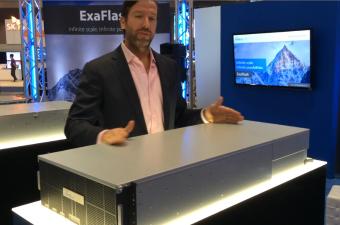
video above shows the 4PB raw ExaFlash
at FMS
Editor's comments:- if there are to be sustainable
roles in the future
consolidated
enterprise SSD systems market for AFA vendors which previously sold arrays
of SAS/SATA SSDs - and who don't own their own semiconductor fabs - the only
viable ways to establish such platform brand identities are with SSD
software and architecture.
There's a huge gap between the technological
aspiration which Nimbus talks about and the weakness of its past marketing and
the kind of
funding which we've
seen competitors in this market burn through in the past with mixed results.
In the next few quarters I hope we'll hear more from Nimbus about its
business development plans and customer adoption.
See also:-
roadmap to the
Petabyte SSD,
the unreal
positioning of many flash array "startups"
Liqid controller inside fastest 2.5" NVMe flash SSD
Editor:-
August 9, 2016 - In a joint
press
release today Liqid
and Kingston
gave details of the "fastest 2.5" PCIe NVMe flash SSD ever
benchmarked" - which they're showing this week at FMS.
- upto 3.9 TB of capacity
- Mixed R/W: ~ 5.5 GB/s (Full Duplex)
- Seq read ~ 3.6 GB/s Seq write ~ 3.6 GB/s
- mixed random R/W ~ 1.15 M
IOPS (4 K,
Full Duplex)
See also:-
2.5" PCIe SSDs,
PCIe SSDs,
SSD controllers
Seagate previews 60TB 3.5" SAS SSD
Editor:-
August 9, 2016 - Seagate
today
said
it 's demonstrating prototypes of a 60TB 3.5" SAS SSD which will be
available next year.
FlexiRemap software wins award at Flash Memory Summit
Editor:-
August 18, 2016 - AccelStor
today announced
it has won the Best-of-Show Technology Innovation Award for its
FlexiRemap software at
the Flash Memory Summit 2016
in Santa Clara, California.
AccelStor's FlexiRemap software improves
performance, cuts down on overhead, and extends SSD lifespan. The technology
achieves sustained performance and reliability even in the random-access
scenarios typical of enterprise storage needs. Thanks to the global
wear-leveling algorithm, FlexiRemap arrays have at least 2x the
endurance
compared to typical legacy RAID
5 flash systems.
new memories? new security risks?
Editor:- August 4,
2016 - Is remanence a security risk in persistent memory? That's the topic of
my new blog
here on
StorageSearch.com
If
you aren't yet ready to evaluate these new SCM style NVDIMMs you might think
you can skip this article.
That's OK as long as you already were aware
that that data recovery
has always been feasible in old style
DRAM too. ...read the
article
former SanDisk CTO joins 3D fabless BeSang
Editor:-
August 2, 2016 - today it was
announced
that Kevin Conley,
former CTO at SanDisk
has joined BeSang
as a member of advisory board where he will help guide the company to find SSD
applications for their 3D Super
NAND nd 3D Super NOR technologies - which unlike conventional
through-silicon vias 3D can "stack high-density, multi-memory layers
sequentially on top of other device layers in a single chip at low cost using
proven material and device technologies."
Radian will sample PCIe based competitor to NVDIMMs
Editor:-
August 2, 2016 - Radian
Memory today
announced
it will be sampling in October a new byte addessable,
regular
(NVRAM-flash cache ratio), 12TB
PCIe SSD which has
on-board host controlled tiering between its flash and NVRAM.
Editor's
comments:- Radian is positioning the new product as a cost effective
alternative competitor to
hybrid NVDIMMs and
similar emerging products in the
SCM DIMM wars
market.
In an interview last year with Radian's CEO Mike Jadon -
what's the role for a
Radian Memory SSD? - I learned more about the company's software thinking.
Diablo gets more funding for Memory1 and DMX software
Editor:-
August 2, 2016 - Diablo
Technologies today
announced
it has secured $37 million across 2 phases of an oversubscribed round of Series
C financing.
New investors Genesis Capital and GII Tech Ventures
joined the second phase of the round, along with follow-on investments from
Battery Ventures, BDC Capital, Celtic House Venture Partners, Hasso Plattner
Ventures and ICV.
Editor's comments:- that's kind of
interesting - but much more interesting from my perspective was what I learned
in a 1 hour conversation with the company last week about the software for their
Memory1 (flash as RAM) product.
Diablo's DMX software is barely
mentioned in the funding PR above. I expected to see more on their web site
about this.
I also learned how Diablo handles the flash and endurance
issues.
Those aspects were mysterious to me when the product was
announced last year. But it's very straightforward.
The best way to
think about the caching and tiering side of things is that Diablo's software
leverages DRAM on the motherboard.
This DRAM (in another socket) must be present for every 1 or 2
Memory1 modules in the system. And in many respects it uses that DRAM and its
own flash in a similar way
to the early Fusion-io
PCIe SSDs and some of the other tiering, caching products we've seen before like
FlashSoft.
Diablo's DMX operates in memory layers and also the company has done machine
learning of popular and proprietary apps it might work with so that it
understands the nature of data demand patterns and structures.
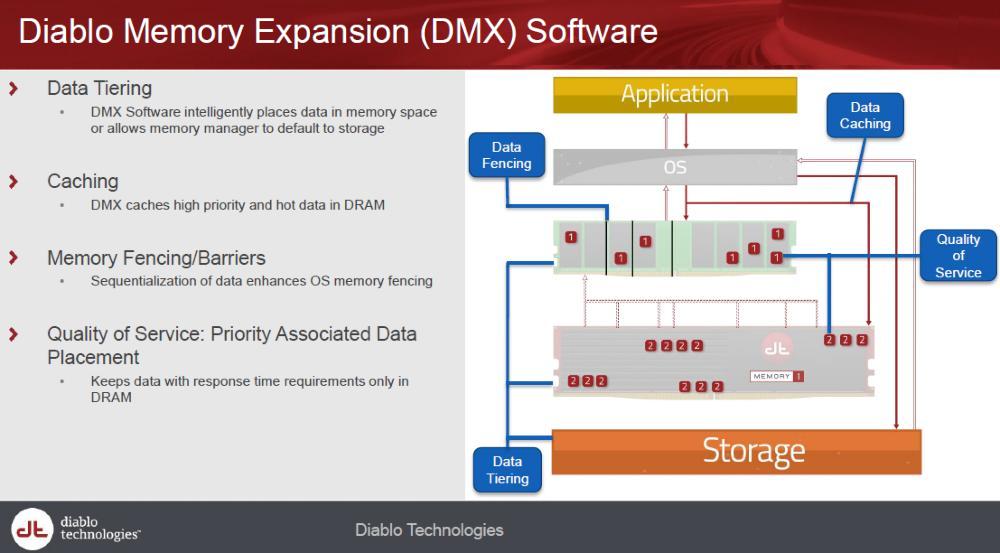
Diablo
says that - unlike NVMe and those other
storage cache / tiering
products - the benchmarks they've done with Memory1 have much more
acceptable operation - because DMX and Memory1 don't have the same variability
of latency which occurs when you go through storage stacks and storage or
network interfaces.
This inconsistency of latency is one of the
problems I wrote about in my classic article on
SSD design
symmetries. And the consistency of - for example -
random IOPS
- was a powerful competitive difference exploited by marketers at enterprise
PCIe SSD pioneer - Virident.
There are always infrequent traffic related congestion and contention
problems in any multi-tiered latency system - even in real world physical
DRAM
controllers.
These rare clogging events (nanoseconds,
microseconds, or milliseconds) accumulate to bigger actual latency numbers in
storage interchanges. So when you're emulating memory with storage - it's not
the best performance which matters. It's the worst case which causes QoS
problems.
Diablo says the ability of DMX to understand data at the
application level and move it between DRAM and flash via the DRAM bus with
native custom silicon
controller support for
these memory movements - gets results which are on average several times better
than the best average PCIe based flash cache alternatives. As you'd expect.
But it's the superiority of the worst case latencies - which can prove
to be the yea or nay breaking point in the selction between DIMM based
flash and other interfaces for critical memory emulation deployments.
DMX
includes a QoS latency feature so that application developers can retain
control of data they like in DRAM without having to rely on caching
intelligence.
Memory1 - from the flash endurance view
The
endurance side of Diablo's Memory1 architecture with DMX software is amazing
straightforward and conventional.
If you think of the "flash SSD"
as being the combination of the flash in the Memory1 DIMM and the compulsory
server DRAM DIMM (on the same server motherboard) then from the flash
SSD controller point
of view the whole system operates adequately with much lower
DWPD requirements than
you'd expect from a memory intensive system.
How can an OK DWPD
flash SSD be good enough to be a DRAM emulator?
There are several
ingredients in the IP juice which - when factored together - greatly reduce
the endurance
loadings on the flash.
- the SSD has a relatively high
RAM to flash cash
ratio compared to most SSDs (because it can use as much if the DRAM as it
needs)
- all writes to the flash array are done as big sequential writes which
since the earliest days of enterprise flash has been demonstrated to improve
reliability and performance.
- write
amplification can be minimized more so than in the best (storage focused)
SSDs because the DMX software understands popular applications and has more
visibility of the memory space and storage space than a typical enterprise SSD.
DMX has control of fetches and lookahead requests from the flash
space and is controlling the memory spaces too. The data locality mechanisms
which assist efficient cachin also reduce stress on endurance too.
Diablo
calls this "intelligent traffic management". This avoids premature
writes to flash for frequently written pages and minimizes read / modfy / write
operations performed on data while it is resident in the flash.
- and finally - when you look at whole DRAM contents - the rate of change of
data in most general purpose enterprise servers (as a percentage of the whole
physical memory capacity) is much less than you might think.
That's
because system software has evolved over many years to keep critical stuff in
memory. You can see more about the DRAM side of queues and caches and DRAM
controller latencies in
this article
here. It's this legacy of virtual memory (memory being the combination of
HDD and DRAM) which is the underlying market enabler of DIMM wars memory
tiering products to deliver cost and power benefits. In Memory1 it's
not the flash or the controllers or the interface or any single aspect of the
design which make this a significant solution which needs to be assessed by big
memory users - it's the integrated systems level operation.
This is
a big
controller architecture approach which integrates chips and its own
flavor of SSDeverywhere
aware software to grab visibility and manage control over many different
elements of the applications delivery experience. | |
| . |
| What happened before?
|
| . | |
| .. |
 |
| seeking the inner SSD
|
| |
|
.. |
|
|
|
. |
|
|
|
. |
|
|
|
. |
|
|
|
. |
|
|
|
. |
|
|
|
. |
|
9 years ago - in
August 2007
Violin Memory launched an assault on the high end RAM SSD acceleration market
with general availability of the highest density rackmount memory system.
|
| SSD market
history | | |
|
|
|
. |
|
|
|
. |
|
 |
|
. |
|
| I think it's not too strong
to say that the enterprise PCIe SSD market (as we once knew it) has exploded and
fragmented into many different directions. |
| what's changed in enterprise
PCIe SSD? | | |
|
. |
|
|
|
|
|
. |
|
|
|
|
| . |
. |
|
|
|
... |
|
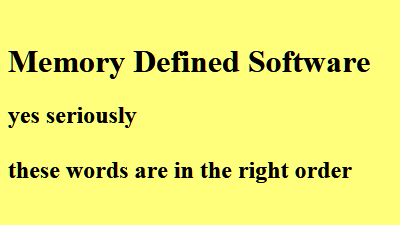 |
|
| |
























